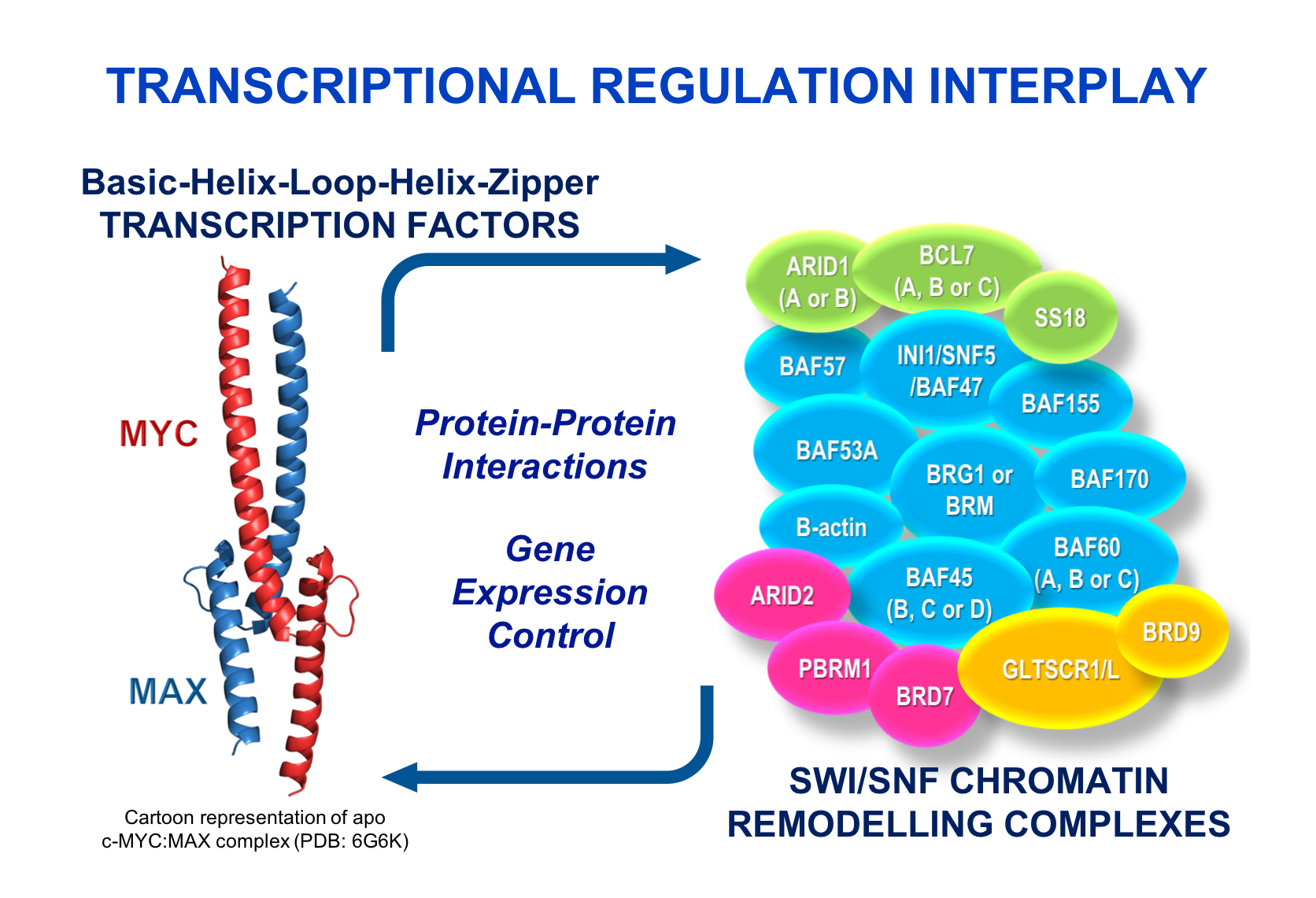
Dr Giovanna Zinzalla
Position: Visiting Researcher - Principal Investigator from the Karolinska Institutet, Sweden.
Personal home page:
https://orcid.org/0000-0002-1130-4865
Email:
gz213@cam.ac.uk
PubMed journal articles - click here
HOW TRANSCRIPTIONAL REGULATORS CONTROL GENE EXPRESSION PROGRAMS AND CELL FATE IN NORMAL AND MALIGNANT CELLS
How the transcriptional machinery orchestrates gene expression programs during development, renewal and in response to environmental signals is one of the outstanding questions in biology. I tackle this fundamental problem by focusing on determining at the molecular level the mechanisms regulating the interactions between transcription factors and their interactions with co-factors, especially with epigenetic regulators.
My work encompasses chemistry, biochemistry, biophysics and structural biology. The ultimate goal is to develop therapeutic agents to treat human diseases, and new approaches for regenerative medicine.
I am currently working on two key molecular machineries: MYC and other members of its Basic-Helix-Loop-Helix-Zipper (bHLHZip) network of transcription factors; and the SWI/SNF (BAF) chromatin remodelling complexes.
Our work on c-MYC is focused on determining: how transcription factor cooperation leads to gene repression; and how the MYC extended network of bHLHLZ transcription factors, i.e., the c-MYC like MONDOA/ChREBP paralogs, regulate metabolism.
Projects on the SWI/SNF complexes are currently directed to understand: how these chromatin remodelling complexes control MYC gene expression; and how the BAF60 and the BAF155/170 subunits, respectively, mediates interactions with diverse transcription factors with roles in cellular processes, such as regeneration, cardiac development and metabolism. We are also exploring ways to target the SWI/SNF complexes for the development of new therapies.
Research Collaborations (alphabetical order): Prof. Don Ayer, Huntsman Cancer Institute, University of Utah, USA; Dr Mark Bycroft, University of Cambridge, Cambridge, UK; Prof. Gerard Evan, University of Cambridge, UK; Prof. Laura Itzhaki, University of Cambridge, Cambridge, UK; Prof. Lars-Gunnar Larsson, Karolinska Institutet, Sweden; Prof. Mark Rubin MD, Bern Center for Precision Medicine (BCPM), University of Bern, Switzerland; Prof. Sophia Yaliraki, Imperial College London, UK.
Transcription factors
SW/SNF (BAF) chromatin remodelling complexes
Protein-protein interactions
Chemical biology
Symplectic Elements feed provided by Research Information, University of Cambridge
SWI/SNF subunit BAF155 N-terminus structure informs the impact of cancer-associated mutations and reveals a potential drug binding site
Allen MD, Freund S, Bycroft M, Zinzalla G
Commun Biol. 2021 May 5;4(1):528.
Structure of the BRK domain of the SWI/SNF chromatin remodeling complex subunit BRG1 reveals a potential role in protein-protein interactions.
Allen MD, Bycroft M, Zinzalla G
Protein Sci. 2020 Apr;29(4):1047-1053.
Crystal Structures and Nuclear Magnetic Resonance Studies of the Apo Form of the c-MYC:MAX bHLHZip Complex Reveal a Helical Basic Region in the Absence of DNA.
Sammak S, Hamdani N, Gorrec F, Allen MD, Freund SMV, Bycroft M, Zinzalla G
Biochemistry 2019 07;58(29):3144-3154
The structure of INI1/hSNF5 RPT1 and its interactions with the c-MYC:MAX heterodimer provide insights into the interplay between MYC and the SWI/SNF chromatin remodeling complex.
Sammak S, Allen MD, Hamdani N, Bycroft M, Zinzalla G
FEBS J. 2018 11;285(22):4165-4180
A selective high affinity MYC-binding compound inhibits MYC:MAX interaction and MYC-dependent tumor cell proliferation.
Castell A, Yan Q, Fawkner K, Hydbring P, Zhang F, Verschut V, Franco M, Zakaria SM, Bazzar W, Goodwin J, Zinzalla G, Larsson LG
Sci Rep 2018 07;8(1):10064
A New Way Forward in Cancer Drug Discovery: Inhibiting the SWI/SNF Chromatin Remodelling Complex.
Zinzalla G
Chembiochem 2016 Apr;17(8):677-82
Targeting protein-protein interactions (PPIs) of transcription factors: Challenges of intrinsically disordered proteins (IDPs) and regions (IDRs).
Sammak S, Zinzalla G
Prog. Biophys. Mol. Biol. 2015 Oct;119(1):41-6
The SWI/SNF Subunit INI1 Contains an N-Terminal Winged Helix DNA Binding Domain that Is a Target for Mutations in Schwannomatosis.
Allen MD, Freund SM, Zinzalla G, Bycroft M
Structure 2015 Jul;23(7):1344-9
Tetracycline analogues with a selective inhibitory effect on HIF-1alpha
Bendiabdellah Y, Rahman, KM, Uranchimeg B, Nahar KS, Antonow D, Shoemaker R.H., Melillo G, Zinzalla G, Thurston, DE
Med. Chem. Commun., 2014,5, 923-926.
Observation of unphosphorylated STAT3 core protein binding to target dsDNA by PEMSA and X-ray crystallography.
Nkansah E, Shah R, Collie GW, Parkinson GN, Palmer J, Rahman KM, Bui TT, Drake AF, Husby J, Neidle S, Zinzalla G, Thurston DE, Wilderspin AF
FEBS Lett 2013 Apr;587(7):833-9
Small-molecule inhibition of c-MYC:MAX leucine zipper formation is revealed by ion mobility mass spectrometry.
Harvey SR, Porrini M, Stachl C, MacMillan D, Zinzalla G, Barran PE
J. Am. Chem. Soc. 2012 Nov;134(47):19384-92
















